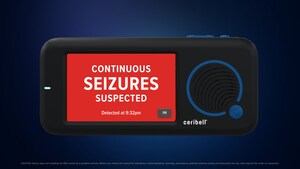Over 99% Of EEG Epileptic Abnormalities Can Be Detected By EEG Systems Without Midline Or Parasagittal Leads
A Retrospective Review of Encephalography (EEG) Data to Assess the Scope of EEG Abnormalities Captured by Midline and Parasagittal Electrodes. Published in Neurocritical Care.
MOUNTAIN VIEW, Calif., Aug. 26, 2019 /PRNewswire/ -- Ceribell, Inc. announced the recent publication of a research study in Neurocritical Care1 that compiled a review of 300 EEGs from a large teaching hospital combined with a literature review of over 169,000 EEGs. The study confirmed that an EEG configuration without electrodes in the parasagittal region (like Ceribell's Rapid Response EEG system) could be effective for the detection of seizures or epileptiform discharges in over 99% of cases. According to the findings of this study, less than 1% of EEGs show midline or parasagittal focal epileptic abnormalities. This study is especially relevant since prospective data from a large multi-center clinical trial, assessing the Ceribell Rapid Response EEG system's utility for fast and accurate detection of seizures, will be presented on October 16th at the Neurocritical Care Society Annual Meeting in Vancouver, BC.
Non-convulsive seizures, including non-convulsive status epilepticus (NCSE), are common in critically ill patients. 90% of these seizures are non-convulsive2 and can only be detected by EEG. Prolonged non-convulsive seizures lead to permanent brain injury, and delayed diagnosis and treatment of NCSE leads to higher morbidity, mortality, and length of hospital stay3. As a result, the current guidelines from the Neurocritical Care Society4 recommend that continuous EEG should be initiated within 15-60 minutes of suspected status epilepticus in all patients. However, meeting this guideline has proven difficult due to limitations of conventional EEG systems. The Ceribell Rapid Response EEG system was developed to address limitations in EEG acquisition and interpretation.
Conventional EEG systems with more electrodes provide better spatial information, however the value of midline and parasagittal electrodes in the evaluation of epileptic activity has not been thoroughly addressed. This study sought to retrospectively review EEG data from 300 patients and compiled literature cases in a meta-analysis to assess the scope of abnormalities captured exclusively by midline parasagittal leads. The objective was to confirm the ability of systems that do not have midline or parasagittal leads to triage seizure activity.
Of the 300 conventional EEGs reviewed, only 2 (0.7%) had focal midline or parasagittal seizures. Further, both of those were also visible in the circumferential EEG channels. A subsequent literature review involving 169,510 EEGs similarly showed less than 1% originated in the midline or parasagittal region.
"The results from this meta-analysis confirm that focal abnormalities in the parasagittal region are rare in adults undergoing EEG monitoring. A device like the Ceribell Rapid Response EEG has the potential to reliably detect seizure activity and improve the care of critically ill patients. As we continue to drive innovation in the field of encephalography, we are excited to share encouraging results from our multi-center clinical trial soon, further building the evidence around the accuracy and utility of our Rapid Response EEG system," said Jane Chao, CEO, Ceribell.
TO LEARN MORE:
Manuscript: https://doi.org/10.1016/j.cnp.2018.03.001
ABOUT THE CERIBELL RAPID RESPONSE EEG SYSTEM
The Ceribell Rapid Response EEG System consists of a 10-electrode (8-channel) headband, an EEG recorder with Brain Stethoscope feature, and a cloud portal for storing and reviewing EEGs. This simplified configuration of EEG enables easy access to EEG within minutes.
The Ceribell EEG System received FDA 510(k) clearance in 2017 and is commercially available in the United States.
ABOUT CERIBELL
Ceribell, Inc. (www.ceribell.com), is headquartered in Mountain View, CA. Ceribell is focused on making EEG widely available, more efficient, and more cost-effective to improve the diagnosis and treatment of patients at risk for seizures.
1Gururangan K. & Parvizi, J. (2019) Midline and parasagittal seizures are rare in adult patients. Neurocrit Care, published online, https://doi.org/10.1007/s12028-019-00804-6
2Friedman, D., Claassen, J. and Hirsch, L.J. (2009) Continuous electroencephalogram monitoring in the intensive care unit. Anesth. & Analg., 109(2):506-23, https://doi.org/10.1213/ane.0b013e3181a9d8b5
3Young, G.B., Jordan, K.G. and Doig, G.S. (1996) An assessment of nonconvulsive seizures in the intensive care unit using continuous EEG monitoring: an investigation of variables associated with mortality. Neurology, 47(1):83-89, https://doi.org/10.1212/wnl.47.1.83
4Brophy et al. (2012) Guidelines for the evaluation and management of status epilepticus. Neurocrit Care, 17(1):3-23, https://doi.org/10.1007/s12028-012-9695-z
SOURCE Ceribell, Inc.
Related Links
WANT YOUR COMPANY'S NEWS FEATURED ON PRNEWSWIRE.COM?
Newsrooms &
Influencers
Digital Media
Outlets
Journalists
Opted In






Share this article